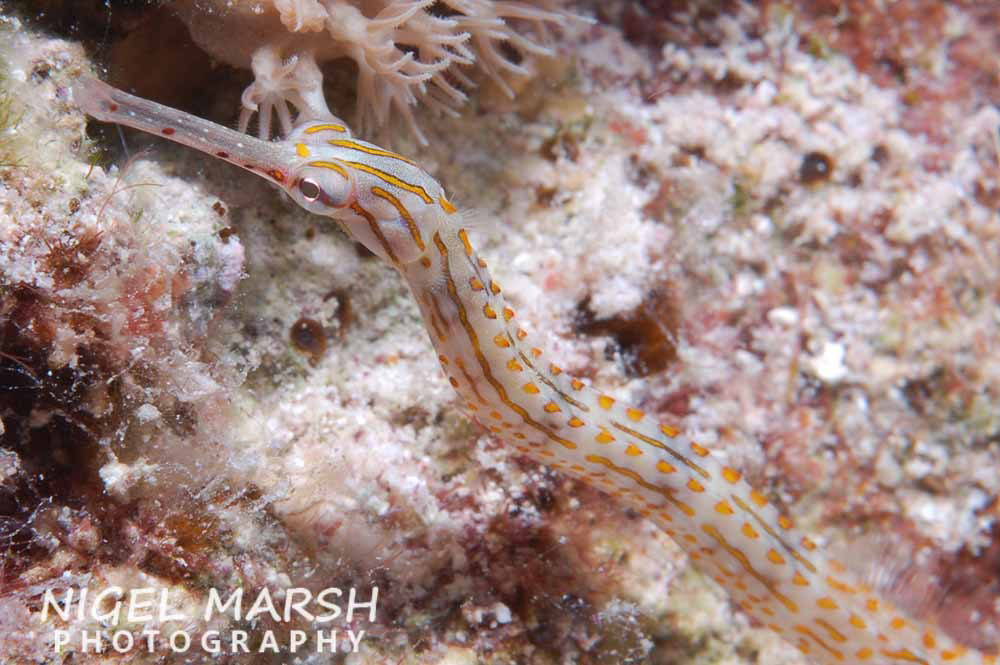Ocellate Pipefish, Corythoichthys ocellatus Herald 1953

An Ocellate Pipefish, Corythoichthys ocellatus, on Marion Reef in the Coral Sea, Australia, May 2008. Source: Nigel Marsh / iNaturalist.org. License: CC by Attribution-NonCommercial
A pale brown pipefish with many distinct dark-edged orange spots or rectangles, whitish speckles, a dark stripe on the lower third of the gill cover extending forward below the eye, and a series of narrow whitish bands encircling the body. Ocellate Pipefish are often seen in pairs on shallow rubble reefs.
Ocellate Pipefish, Corythoichthys ocellatus Herald 1953
More Info
|
Distribution |
Tropical Western Central Pacific, from Indonesia, the Philippines, Palau, Papua New Guinea, the Solomon Islands, Fiji and Australia. Known from the Great Barrier Reef, Queensland; inhabits coral rubble, algal reefs and inshore areas to about 15 m. |
|
Features |
Dorsal fin 22-25; Trunk rings 15-16; Tail rings 29-32. Head length in SL 5.7-7.1; body depth in HL 3.5-5.4; snout long, snout length in HL 1.7-2.0, snout depth in snout length 7.3-8.8; prenuchal and nuchal ridges smooth; median snout ridge usually with slight dorsal emargination; eye prominent. Dorsal fin origin usually at or behind the anterior margin of the first tail ring. |
|
Size |
To 11 cm TL |
|
Colour |
Overall light greenish-yellow, body covered in small pupil-sized orange spots that are often dark ringed as ocelli, especially over the back of the trunk; ventral surface of anterior 4-5 trunk rings heavily shaded or blotched with brown; no dark blotch ventrally on anal ring; head with diffuse dark stripe on lower third of opercle extending forward below eye; dorsal fin without spots. |
|
Feeding |
Unknown, likely to feed on copepods, small isopods and ostracods. |
|
Biology |
Reproduction: Ovoviviparous (gives birth to live young). The eggs are brooded by the males in a pouch under the tail. The pouch protects the dorsal surface and side of the egg mass, leaving the ventral surface is exposed. Males begin brooding at around 58 mm SL. Eggs: Eggs deposited in 2-17 transverse rows within a gelatinous matrix. Larvae: Pelagic; morphologically similar to adults at birth. |
|
Fisheries |
Sometimes collected for the aquarium trade. |
|
Conservation |
Australian Government Legislation: Marine listed under the Environment Protection and Biodiversity Conservation Act 1999. |
|
Remarks |
Individuals are either found solitary or in pairs. |
|
Similar Species |
Colour pattern similar to that of C. schultzi. The long snout and ocellate markings separate C. ocellatus from all other congeners except C. schultzi. C. ocellatus has lower total ring and dorsal ray counts (average = 46 and 23 versus 51 and 28 in C. schultzi) and the ventral surface of the trunk rings is more heavily pigmented. C. schultzi also reaches a larger size (144 mm versus around 120 mm in C. ocellatus). |
|
Etymology |
Corythoichthys is from the Greek, korys, korythos for helmet and ichtys meaning fish. The specific name ocellatus is for the dark-ringed ocelli on the body. |
|
Species Citation |
Corythoichthys ocellatus Herald 1953, Bull. U.S. Natl. Mus. 202(1): 267, fig. 41a, Purvis Bay, Florida Island, Solomon Islands. |
|
Author |
Thompson, Vanessa J. & Dianne J. Bray |
Ocellate Pipefish, Corythoichthys ocellatus Herald 1953
References
Allen, G.R. & M. Adrim. 2003. Coral reef fishes of Indonesia. Zool. Stud. 42(1): 1-72.
Allen, G.R. & M.V. Erdmann. 2008. Corythoichthys benedetto, a new pipefish (Pisces: Syngnathidae) from Indonesia and Papua New Guinea. Aqua, International Journal of Ichthyology 13(3-4): 121-126.
Dawson, C.E. 1977. Review of the Pipefish genus Corythoichthys with description of three new species. Copeia 1977(2): 295-338
Dawson, C.E. 1985. Indo-Pacific Pipefishes (Red Sea to the Americas). Gulf Coast Research Laboratory, Ocean Springs, Mississippi. 230 pp.
Herald E.S. 1953. Family Syngnathidae: pipefishes, pp. 231-278, figs 36-44 In: Schultz L.P., Herald E.S., Lachner E.A., Welander A.D. & Woods L.P. (eds). Fishes of the Marshall and Marianas Islands. Vol. 1. Families Asymmetrontidae through Siganidae. Bull. U.S. Natl. Mus. 202(1): 1-685, figs. 1-90
Hoese, D.F., D.J. Bray, J.R. Paxton & G.R. Allen. 2006. Fishes. In Beesley PL & Wells A (eds) Zoological catalogue of Australia. Volume 35 ABRS & CSIRO Publishing: Australia 2178 pp.
Kuiter, R.H. 2000. Seahorses, Pipefishes and their Relatives. Chorleywood, UK: TMC Publishing. 240 pp.
Laboute, P. & R. Grandperrin. 2000. Poissons de Nouvelle-Calédonie. Editions Catherine Ledru: 520 pp.
Myers, R.F. 1999. Micronesian reef fishes. A comprehensive guide to the coral reef fishes of Micronesia. 3rd revised ed. Coral Graphics, Guam. 330 pp, 192 pls.
Pogonoski, J.J., D.A. Pollard & J.R. Paxton. 2000. Conservation Overview and Action Plan for Australian Threatened and Potentially Threatened Marine and Estuarine Fishes. Environment Australia, Canberra. 375 pp.
Randall, J.E., G.R. Allen & R.C. Steene. 1997. Fishes of the Great Barrier Reef and Coral Sea. Crawford House Publishing, Bathurst, Australia.






